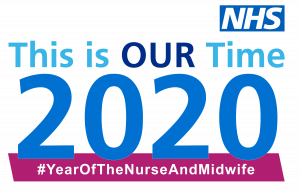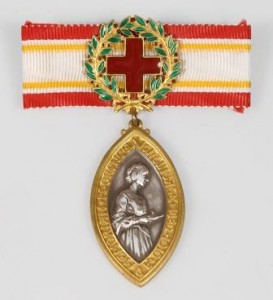The Lady with the Lamp – Happy 200th Birthday Florence Nightingale!
 2020 has been designated as the International Year of the Nurse and Midwife by the World Health Organisation (WHO) inspired by the most famous nurse of all, Florence Nightingale’s 200th birthday on 12 May.
2020 has been designated as the International Year of the Nurse and Midwife by the World Health Organisation (WHO) inspired by the most famous nurse of all, Florence Nightingale’s 200th birthday on 12 May. Nurses and midwives make up the largest numbers of the NHS workforce and play a crucial role in helping to deliver health services. They care for mothers and children; giving lifesaving immunisations and health advice; looking after older people and being involved with the provision of everyday essential health needs. They are often the first point of contact in their local communities and are highly skilled professionals from a range of backgrounds that represent diverse communities.
Portland Basin Museum had planned to install a display in the doctor’s surgery on the 1920s street to mark this event. However in light of the fact the museum is closed due to the coronavirus we feel it is even more important that we commemorate this event to honour the contribution of the NHS to the fight against this global pandemic.
Photograph by Henry Hering c1860. Credit: NPG London
Florence Nightingale was born on 12 May 1820 into a wealthy family and named after the Italian city of her birth.
The family moved to England in 1821 and she was brought up in the family homes in Hampshire and Derbyshire. Even during her younger years she felt drawn towards a life devoted to the service of others. She believed she had a call from God to pursue this way of life and become a nurse. At the age of seventeen Florence refused a marriage proposal from the politician and poet Richard Monckton Milnes as she felt her ‘moral active nature requires satisfaction and would not find it in this life.’ In 1844 she announced her intention to become a nurse. Her parents objected to her choice as it was against their expectations of a woman of her status whose typical roles were of wife and mother.
Florence’s nursing training was at the Lutheran Hospital of Pastor Fliedner in Germany. After qualifying as a registered nurse Florence returned to London to take her first nursing job which was Superintendant at the Institute for the Care of Sick Gentlewomen in Upper Harley Street London in October 1854.
Her next challenge was on the horizon. In October 1853 the Crimean war broke out. This was a military conflict between October 1853 and February 1856 involving the Russian empire at war with the Ottoman Empire, France, the United Kingdom and Sardinia. Florence became aware of the horrific conditions for the sick and wounded soldiers. On 21 October 1854 she and a number of volunteer nurses travelled to the Ottoman Empire. They arrived early in November 1854 at Selimiye Barracks in Scutari, Turkey. There was very poor care for soldiers and overworked staff. Medicines were in short supply, hygiene was neglected and mass infection was common. More soldiers were dying from disease such as typhus and cholera than their wounds. Florence was horrified and sent an appeal to The Times for a solution. In response Isambard Kingdon Brunel designed a prefabricated hospital to be shipped to the Dardanelles. During this time it has also been suggested that she reduced the death rate from 42% to 2% by introducing improved infection control and hygiene such as hand washing.
During the Crimean War she earned her famous title ‘The Lady with the Lamp’.
A contemporary report in The Times stated:
“She is a "ministering angel" without any exaggeration in these hospitals, and as her slender form glides quietly along each corridor, every poor fellow's face softens with gratitude at the sight of her. When all the medical officers have retired for the night and silence and darkness have settled down upon those miles of prostrate sick, she may be observed alone, with a little lamp in her hand, making her solitary rounds.”
Reproduction of a painting of Florence Nightingale by Henrietta Rae 1891.
Credit: Wellcome Collection
In the Crimea on 29 November 1855 the Nightingale Fund was established for the training of nurses during a meeting to acknowledge her role in the war. There was an outpouring of donations. This provided £45,000 to set up the Nightingale Training School at St Thomas’ Hospital on 9 July 1860 which is now part of King’s College London. The first trained Nightingale nurses began work on 16 May 1865 at Liverpool Workhouse Infirmary. The introduction of nurses into the workhouse system from the 1860s is regarded as one of her main achievements.
Florence Nightingale Faculty of Nursing, Midwifery and Palliative Care
From 1925, Nightingale badges were awarded to all nurses that completed their training at the Florence Nightingale School of Nursing, St Thomas’ Hospital and had served for a fixed period as a junior staff nurse in the hospital . This example dates from 1970 and was awarded to Sandra Richards. |
Florence Nightingale medal awarded to Sandra Richards for high marks in nursing theory and practice exams, 1970 |
In 1859 she wrote ‘Notes on Nursing’ written especially for nursing at home – it became the curriculum for the Nightingale School and is known as a classic introduction to nursing.
In the 1870s she mentored Linda Richards, America’s first trained nurse whom returned to the States with the knowledge and ability to set up nursing schools. In 1883 she was the first recipient of the Royal Red Cross Medal and in 1904 she was appointed a Lady of Grace of the Order of St John.
From 1857 onwards she spent periods of her life bedridden and suffering from depression. In hindsight it is thought she was probably suffering from brucellosis which is an infectious disease caught from drinking unpasteurized milk or eating undercooked meat from infected animals and not really known about until the 1870s. Even during these periods of ill health she was productive in social reform and involved in field hospital planning. She died in her sleep on 13 August 1910 at the age of 90. Her family declined an offer of a burial at Westminster Abbey and she was buried at St Margaret’s Church, East Wellow near one of the family homes.
Credit: Dmartin@ukonline.co.uk
Her legacy:
The legacy she left is immense. She founded the modern nursing profession and set an example of compassion and prioritising patient care through effective hospital administration. She set up the first official nurses training programme in 1860 and in 1912 the International Committee of the Red Cross introduced the Florence Nightingale medal which is awarded every two years to nurses for outstanding service.

Credit: Roy Cameron
Since 1965 International Nurses Day has been celebrated on her birthday every year. During the current pandemic the temporary hospitals opened in various parts of the country have been called the ‘NHS Nightingale Hospitals’.
There are two significant local nurses that I would like to include in this celebration of nursing and midwifery.
Credit : Tameside Hospital
Charlotte Seymour Yapp (1879 - 1934)Charlotte Seymour Yapp was born in Ardwick in 1879 and trained as a nurse in Birmingham completing her training in 1903. She gained a certificate in midwifery, carried out private work and worked as an infant health inspector in Lancashire. Between 1914 and 1925 she was Matron of the Lake Hospital, a purpose built 300 bedded hospital attached to the Ashton-under-Lyne workhouse which was on the site of the current Tameside Hospital. She is regarded as one of the most influential children’s nurses of her time in the United Kingdom. She helped develop the Royal College of Nursing, promoted registration for nurses and helped to develop the General Nursing Council.
Lakes Hospital staff c1914
Courtesy of Tameside Local Studies and Archives
Clarinda Rowbotham -photograph courtesy of Rita Vaughan
Clarinda Rowbotham (1885 -1962)
Clarinda Rowbotham was born in Hyde in 1885 and by 1901 was working as a cotton cardroom hand living in Mossley. Before 1911 she was the first school nurse for Mossley also becoming as a midwife, health visitor and state registered nurse (SRN) during her lifetime. She was also the Lady Superintendant of the Mossley Branch of the St John Ambulance Brigade for 50 years. During WW1 she was the unpaid sister in charge at Mossley Military Hospital caring for over 500 wounded and convalescing soldiers from Britain and Belgium combining this with her duties as school nurse. For this wartime role she was awarded the Associate Royal Red Cross in 1921 and awarded the Service Medal of the Order of St John in 1926. In WWII she provided first aid service to the air raid shelters in Mossley and was awarded the Defence Medal. During the 1940s she lived at 1, Seel Street Mossley where there is a blue plaque to commemorate her.
Clarinda’s medals : L-R : Royal Red Cross, The Order of St John of Jerusalem, Defence Medal, St John Service Medal.
Credit: Dix Noonan Webb Ltd.
After the war she worked at the local GP’s practice and although she retired in 1948 she continued with her Mossley St John Ambulance work until 1962 which was the year of her death. She is buried at St George’s Church in Mossley.
In the museum collections we have several items relating to local nurses.
These items belonged to Nurse Harriet Firth. The Latin inscription on the bronze nursing medal means ‘Never Not Ready’. It is believed to be a privately bought nursing or midwifery badge which were bought by nurses from hospitals that didn’t issue their own badges. Medals were then engraved with details of the nurse or training hospital.
The image on the badge is Florence Nightingale with her lamp and a feeding cup. The back of the badge is engraved ‘H.F. 1914’ presumably as Harriet completed her training to be part of the nursing community in WW1
This midwife’s case and contents was gifted to the collections three years ago. It was used by Nurse Annie Tomlinson who was the midwife for Audenshawe, Clayton and Droyslden in the 1920s.
We are interested in acquiring more Tameside related nursing material for the museum and are also currently thinking about how we can reflect people’s experiences of coronavirus in our collections.
If you have any items you think we may be interested in please contact Michelle Hill, Curator at michelle.hill@tameside.gov.uk
There is also a range of local nursing and hospital related photographs in Tameside Local Studies and Archives image archive. Please go to their website www.tameside.gov.uk/archives to access this resource.
Mottram Old Hall as a Red Cross Hospital WW1
|
Ashton District Infirmary, Women’s ward 1910
|
Corkerton/Hodge family of Ashton-under-Lyne
|
With thanks to Rita Vaughan, Joshua Hall, Sandra Graham(nee Richards), Alex Leese and Tameside Local Studies and Archives for their assistance with this article.

